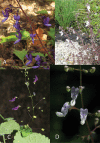Nomenclatural changes in Coleus and Plectranthus (Lamiaceae): a tale of more than two genera
- PMID: 31523157
- PMCID: PMC6717120
- DOI: 10.3897/phytokeys.129.34988
Nomenclatural changes in Coleus and Plectranthus (Lamiaceae): a tale of more than two genera
Abstract
A synopsis of the genera Coleus Lour, Equilabium A.J.Paton, Mwany. & Culham and Plectranthus L'Hér. (Lamiaceae, Tribe Ocimeae, Subtribe Plecranthinae) is presented. Generic delimitation follows a recently published molecular phylogeny which identified Coleus as the sister of the remaining genera of Subtribe Plectranthinae; Plectranthus as sister to Tetradenia Benth. and Thorncroftia N.E.Br., and a separate phylogenetically distinct genus Equilabium comprising species previously placed in Plectranthus. In this treatment, 294 species of Coleus, 42 of Equilabium, and 72 of Plectranthus are recognized. All but one of the combinations in Equilabium are new as only the genus and type species have been previously published. Two-hundred and twelve names are changed to combinations in Coleus from Plectranthus, Pycnostachys Hook. and Anisochilus Benth.
Keywords: Anisochilus; Equilabium; Plectranthinae; Pycnostachys; Solenostemon; Ocimeae; generic delimitation; nomenclature.
Figures









References
-
- Bentham G. (1832) Tribe Ocimoideae in Labiatarum genera et species: or, a description of the genera and species of plants of the order Labiatae with their general history, characters, affinities, and geographical distribution. J Ridgway and Sons, London, 151 pp.
-
- Bentham G. (1848) Tribe Ocimoideae. In: Candolle AP de. (Ed.) Prodromus Systematis Naturalis.Treuttel et Würtz, Paris, 12: 30–148.
-
- Bentham G. (1876) Tribe Ocimoideae. In: Bentham G, Hooker JD. (Eds) Genera Plantarum. Reeve & Co.Williams & Norgate, London 2: 1162–1164.
-
- Blake ST. (1971) A revision of Plectranthus (Labiatae) in Australasia. Contributions from the Queensland Herbarium 9: 1–120. 10.5479/si.00810282.75 - DOI
-
- Briquet J. (1897) Tribe Ocimoideae. In: Engler A, Prantl K (Eds) Naturlichen Pflanzenfamelien, Treuttel et Würtz (Paris) 4(3a): 331–374.
LinkOut - more resources
Full Text Sources
